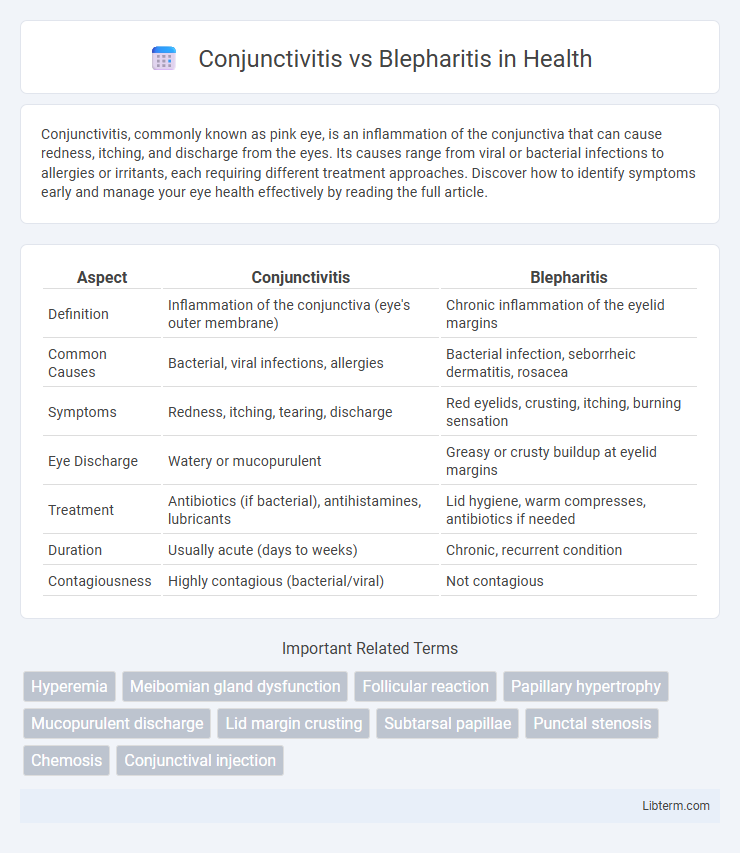Conjunctivitis, commonly known as pink eye, is an inflammation of the conjunctiva that can cause redness, itching, and discharge from the eyes. Its causes range from viral or bacterial infections to allergies or irritants, each requiring different treatment approaches. Discover how to identify symptoms early and manage your eye health effectively by reading the full article.
Table of Comparison
| Aspect | Conjunctivitis | Blepharitis |
|---|---|---|
| Definition | Inflammation of the conjunctiva (eye's outer membrane) | Chronic inflammation of the eyelid margins |
| Common Causes | Bacterial, viral infections, allergies | Bacterial infection, seborrheic dermatitis, rosacea |
| Symptoms | Redness, itching, tearing, discharge | Red eyelids, crusting, itching, burning sensation |
| Eye Discharge | Watery or mucopurulent | Greasy or crusty buildup at eyelid margins |
| Treatment | Antibiotics (if bacterial), antihistamines, lubricants | Lid hygiene, warm compresses, antibiotics if needed |
| Duration | Usually acute (days to weeks) | Chronic, recurrent condition |
| Contagiousness | Highly contagious (bacterial/viral) | Not contagious |
Understanding Conjunctivitis and Blepharitis
Conjunctivitis is an inflammation of the conjunctiva, the clear tissue covering the white part of the eye and inner eyelids, often caused by bacterial or viral infections, allergies, or irritants. Blepharitis involves inflammation of the eyelid margins, typically resulting from clogged oil glands or bacterial overgrowth, leading to redness, itching, and flaky skin around the eyes. Proper diagnosis differentiates conjunctivitis's watery or sticky discharge from blepharitis's crusty buildup, guiding effective treatment strategies.
Key Differences Between Conjunctivitis and Blepharitis
Conjunctivitis, commonly known as pink eye, primarily affects the conjunctiva, causing redness, itching, and discharge, often due to infections or allergies. Blepharitis involves inflammation of the eyelid margins, leading to symptoms like crusty eyelids, burning, and flaking, typically related to bacterial infection or seborrheic dermatitis. The key differences include the affected areas--conjunctiva in conjunctivitis versus eyelids in blepharitis--and the nature of symptoms, where conjunctivitis presents with watery or purulent discharge and blepharitis with eyelid crusting and irritation.
Causes of Conjunctivitis
Conjunctivitis, commonly known as pink eye, is primarily caused by viral or bacterial infections, allergens, and irritants such as smoke or chlorine. Viral conjunctivitis is often linked to adenoviruses, while bacterial conjunctivitis typically involves Staphylococcus aureus or Streptococcus pneumoniae. Unlike blepharitis, which results from inflammation of the eyelid margins due to bacterial colonization or skin conditions like rosacea, conjunctivitis directly affects the conjunctiva, leading to redness and discharge.
Causes of Blepharitis
Blepharitis is primarily caused by bacterial infections, particularly Staphylococcus species, and dysfunction of the oil glands in the eyelids, leading to inflammation and irritation. Unlike conjunctivitis, which is often caused by viral or allergic reactions affecting the conjunctiva, blepharitis results from chronic inflammation of the eyelid margins. Factors such as seborrheic dermatitis, rosacea, and clogged Meibomian glands significantly contribute to the development and persistence of blepharitis.
Common Symptoms of Conjunctivitis
Conjunctivitis, commonly known as pink eye, presents with symptoms such as redness, itching, increased tear production, and a gritty feeling in the eye. It often causes discharge that can be watery, mucous, or pus-like, leading to crusting on the eyelids, especially after sleep. Unlike blepharitis, which primarily affects the eyelid margins, conjunctivitis primarily inflames the conjunctiva, the thin membrane covering the white part of the eye.
Common Symptoms of Blepharitis
Blepharitis presents with common symptoms such as red, swollen, itchy eyelids, flaky skin at the base of the eyelashes, and a gritty or burning sensation in the eyes. Unlike conjunctivitis, which primarily affects the conjunctiva causing eye redness and discharge, blepharitis specifically involves inflammation of the eyelid margins. Persistent eyelid crusting and sensitivity to light are also characteristic signs distinguishing blepharitis from conjunctivitis.
Diagnosis: Conjunctivitis vs Blepharitis
Conjunctivitis diagnosis involves identifying redness, discharge, and irritation of the conjunctiva through clinical examination and sometimes bacterial or viral cultures. Blepharitis diagnosis centers on inspecting eyelid margins for inflammation, crusting, and eyelash debris, often using slit-lamp biomicroscopy. Differentiating the two conditions relies on localized signs--conjunctiva inflammation in conjunctivitis versus eyelid margin involvement in blepharitis.
Treatment Options for Conjunctivitis
Treatment options for conjunctivitis primarily include antibiotic eye drops or ointments for bacterial causes, antiviral medications for viral infections, and antihistamines or mast cell stabilizers to address allergic conjunctivitis. Proper hygiene, such as frequent handwashing and avoiding eye rubbing, helps prevent the spread of infectious conjunctivitis. Severe or persistent cases may require prescription corticosteroid eye drops to reduce inflammation.
Treatment Options for Blepharitis
Blepharitis treatment primarily involves maintaining eyelid hygiene through regular warm compresses and gentle eyelid scrubs to reduce inflammation and bacterial buildup. Topical antibiotics such as erythromycin or bacitracin ointments may be prescribed to control bacterial infection, while oral antibiotics like doxycycline are used for more severe or chronic cases. Anti-inflammatory medications, including corticosteroid eye drops or ointments, can help alleviate symptoms, but must be used under medical supervision to prevent potential side effects.
Prevention Tips for Eye Infections
Maintaining rigorous hand hygiene and avoiding touching or rubbing the eyes significantly reduce the risk of conjunctivitis and blepharitis infections. Using clean towels, removing eye makeup thoroughly, and regularly disinfecting contact lenses prevent bacterial and viral contamination. Regularly replacing pillowcases and avoiding sharing personal eye care products also play crucial roles in preventing these common eye infections.
Conjunctivitis Infographic

 libterm.com
libterm.com